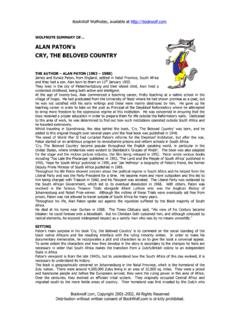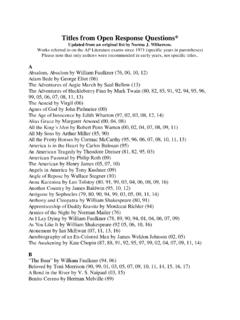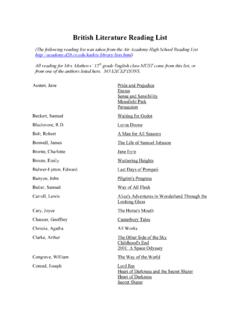Transcription of Cry, the beloved Country - Anke Noss
1 The Broken Tribe' in alan paton 's Cry, the beloved Country Lehrveranstaltung: Postmodernist Writing from South Africa Dozentin: Prof. Dr. Jana Gohrisch Institut: Englisches Seminar Leibniz Universit t Hannover Name, Matrikelnummer: Anke No , 2462350. Studiengang: LbS Farbtechnik und Raumgestaltung/Englisch Fachsemester: 8/5. Abgabe: The Broken Tribe' in alan paton 's Cry, the beloved Country 1 2 Characterization of the Broken Tribe'..3. 3 Contrast between rural and urban Settings ..5. Country ..5. Town ..7. 4 The Role of Christian Religion ..9. 5 Conclusion ..11. 6 Bibliography ..13. The Broken Tribe' in alan paton 's Cry the beloved Country 1 Introduction alan paton 's novel Cry, the beloved Country embraces many themes that are, especially for its time and setting, humanitarian and visionary. Not wholly without reason was the novel very successful around the world and praised by many critics. alan paton who lived and worked in South Africa wrote the novel while visiting Europe.
2 It was first published in the United States in 1948, shortly before the National Party was elected in South Africa and started to institutionalize racial segregation with their policy of apartheid. Since then the novel has had great success all over the world. It has been translated into twenty languages and more than 15. million copies had been sold before Paton's death in 1988 (Callan: 1991, 17). In the novel, and in other publications that would follow, Paton addresses the situation in South Africa from a very liberal and consolidating point of view. He argues that many of the interracial problems in South Africa, especially the so-called problem of native crime' can be explained with the social conditions brought on by the colonization. His white characters Arthur and James Jarvis appreciate this and accept their moral responsibility to improve the situation. They understand, as alan paton understands, that it is not enough to recognize a problem.
3 One also has to face the consequences and take individual measures to improve the situation. For this reason Paton's novel was called a novel of rehabilitation and restoration by Paton's most active critic Edward Callan (Callan: 1991, 97). The novel was however also celebrated by other critics: It has been praised as a moving representation of the tragic plight of black-skinned people in a white man's world (Prescott: 1948, 573). and said to give hope that interracial problems might be solved in the future. It is steeped in sadness and grief over man's inhumanity to man; but it is illuminated by hope and compassion. There is a generosity of spirit here which is rare as it is beautiful and moving (ibid.). After the National Party had won the 1948 elections and public attention was focussed on the policy of apartheid, the book was claimed to convey a serious and moving analysis of South Africa's most disturbing problem (Times Literary Supplement: 1948, 593).
4 Even today numerous websites show that the book is still read by many people around the world and is included into educational reading assignments. In September 2003 it was recommended by Oprah's Book Club (Oprah Website). Two films were made from the novel, one by Zoltan Korda in 1951 and 1. The Broken Tribe' in alan paton 's Cry the beloved Country one by Darell Roodt in 1995. A first stage version, the musical Lost in the Stars by Maxwell Anderson and Kurt Weill was opened on Broadway at the Music Box Theatre on October 30, 1949. A second one, the theatre version by South African playwright Roy Sargeant, was first staged at the National Arts Festival in Grahamstown, Eastern Cape on 27 June 2003. All this shows that Cry, the beloved Country continues to contribute an important part of South African literature and to be valued as expression of white South African opposition to racism and racial segregation. An informed reading of the novel however shows that there are also ideas in the book, which were shared by the advocates of racial segregation.
5 The plot deals with the African community around the priest Stephen Kumalo, which suffers from disorientation and loss of morality. The destruction of the old tribal structures by white colonization is identified as a reason for this. It is easy to understand that alan paton uses this fictional community to refer to problems he saw in the reality of South Africa. By employing the fate of Stephen Kumalo's he demonstrates how black people are unable to cope in a society which is not their own. This change in society is given a name, the broken tribe' which becomes a title for a phenomenon called detribalization' by anthropologists of the time (Collins: 1953). It describes the breaking away of the traditional way of life, along with its customs and hierarchical structures, after the white colonizers came and forced their society onto the peoples who lived in their colonies. In Paton's novel this mainly becomes a problem when black people leave their African communities to go to the white man's cities.
6 Paton describes several examples of moral decay and confusion. As a solution the novel suggests that white men need to help to construct a compensation for the broken'. tribal structures. In the novel this is done by promoting the rural communities. A. similar idea was one of the leading arguments for apartheid and lead to the strict segregation of African peoples according to racial categories, also euphemistically called separate development . This in mind one cannot continue to praise the novel as a supreme piece of reconciliatory literature which gives hope that understanding between different peoples might be possible. It must be read as a historical cultural expression, derived from a mentality which possibly did not support the crimes done by apartheid, nevertheless was not able to set anything against it. 2. The Broken Tribe' in alan paton 's Cry the beloved Country 2 Characterization of the Broken Tribe'. The beginning of the novel shows Stephen Kumalo and his wife in their home together with a child, who has brought a letter.
7 This letter urges Kumalo to come Johannesburg because his sister is very sick (14). Kumalo is presented as a fatherly figure, offering food to the girl, who is obviously hungry. The girl represents the community in Kumalo's congregation: they are hungry and do not own much. The girl marvels at the size of the priests house, at the furniture, which obviously does not exist in her home, and at the books, more even than the books at the school 1 (12). The community in Ndotcheni is falling apart. The ground does not feed them any more and their young people go to Johannesburg, to work in the goldmines. Too many cattle have to be fed by not enough grass, because the number of cattle one owns is a sign of wealth. The farming is done by the remaining old people, who do not have enough strength to cultivate the land properly. The soil is eroded and not much grows there. Children are starving, because there is neither milk nor meat nor vegetable to feed them.
8 The people need moral support and turn to their priest. However, Stephen Kumalo has his own worries. His brother John has gone to Johannesburg to try his luck, his sister Gertrude has gone to Johannesburg to search for her husband and his son Absalom has gone to Johannesburg to look for both of them. Kumalo and his wife have heard from neither of them ever since. When the Kumalos discuss which money can be spent on the trip to Johannesburg, the hopelessness of the situation becomes obvious. Stephen Kumalo refuses to use the money the couple has saved for their son's education, but his wife reminds him that Absalom will never go to 's. [ ] He is in Johannesburg. When people go to Johannesburg, they never come back (15). Repeatedly Paton stresses that there is fear in the land. For the black priest this is the fear of a man who lives in a world not made for him, whose own world is slipping away, dying, being destroyed, beyond any recall (20).
9 This introduces the theme of the broken tribe', which is identified as the main problem of the black community. It seems that hunger and poverty could be dealt with, if only the old tribal structures, which kept the community together, would still exist. The problem is first mentioned when Kumalo has arrived in the Mission House in Sophiatown and talks to the Anglican priests who receive him there. They 1. The same house is later described as a sad place [ ] a dirty old wood-and iron church, patched and forlorn, and a dirty old parson by the white farmer James Jarvis (132). 3. The Broken Tribe' in alan paton 's Cry the beloved Country talk of the sickness of the land, of the broken tribe and the broken house, of young men and young girls that went away and forgot their customs, and lived loose and idle lifes (26). Kumalo is presented as rather helpless and unable to deal with this changing of the world around him. His fear deepens when Msimangu, the Anglican priest who called him to Johannesburg, tells him about the fate of his sister, who has become a prostitute and his brother, who has no use for the church anymore (29).
10 Unlike Kumalo, Msimangu recognizes that this development cannot be stopped. The tragedy is not that things are broken. The tragedy is that they are not mended again. The white man has broken the tribe. [ ] it cannot be mended again. [ ] It suited the white man to break the tribe. But it has not suited him to build something in the place of what is broken. (30). Msimangu voices Paton's conviction that although tragic, it is not possible to stop this development. Instead of wasting one's powers to stop a development that is unstoppable, it would be better to confront the situation as it is and find a way to replace what has been lost. Paton sees the white man's guilt and repeatedly stresses the moral responsibility to replace of the traditional tribal structures that were broken. Arthur Jarvis, who in the novel represents a sophisticated white man's view, writes in one of his essays: It was permissible to allow the destruction of a tribal system that impeded the growth of the Country .


